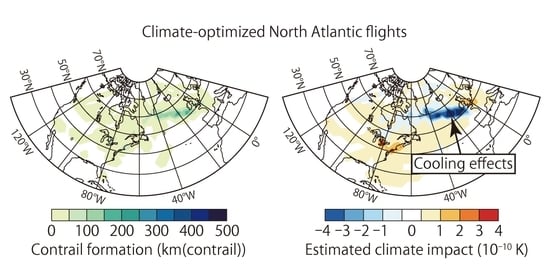Analysis of Aircraft Routing Strategies for North Atlantic Flights by Using AirTraf 2.0
Abstract
1. Introduction
2. Methods
2.1. Weather Pattern Analysis
2.2. Air Traffic Simulation
2.3. Formulations of Objective Functions for the COC, Contrail and Climate Routing Options
2.3.1. COC
2.3.2. Contrail Formation
2.3.3. Climate Impact
3. Characteristics of North Atlantic Weather Patterns
4. Characteristics of North Atlantic Aircraft Routing Strategies
5. Discussion
6. Conclusions
Author Contributions
Funding
Institutional Review Board Statement
Informed Consent Statement
Data Availability Statement
Acknowledgments
Conflicts of Interest
Appendix A. Formulation of Flight Trajectory Optimization

References
- Skeie, R.B.; Fuglestvedt, J.; Berntsen, T.; Lund, M.T.; Myhre, G.; Rypdal, K. Global temperature change from the transport sectors: Historical development and future scenarios. Atmos. Environ. 2009, 43, 6260–6270. [Google Scholar] [CrossRef]
- Lee, D.; Fahey, D.W.; Forster, P.M.; Newton, P.J.; Wit, R.C.N.; Lim, L.L.; Owen, B.; Sausen, R. Aviation and global climate change in the 21st century. Atmos. Environ. 2009, 43, 3520–3537. [Google Scholar] [CrossRef] [PubMed]
- Lee, D.; Pitari, G.; Grewe, V.; Gierens, K.; Penner, J.; Petzold, A.; Prather, M.; Schumann, U.; Bais, A.; Berntsen, T. Transport impacts on atmosphere and climate: Aviation. Atmos. Environ. 2010, 44, 4678–4734. [Google Scholar] [CrossRef] [PubMed]
- Brasseur, G.P.; Gupta, M.; Anderson, B.E.; Balasubramanian, S.; Barrett, S.R.H.; Duda, D.P.; Fleming, G.G.; Forster, P.M.; Fuglestvedt, J.; Gettelman, A.; et al. Impact of Aviation on Climate: FAA’s Aviation Climate Change Research Initiative (ACCRI) Phase II. Bull. Am. Meteorol. Soc. 2016, 97, 561–583. [Google Scholar] [CrossRef]
- ICAO’s Annual Report of the Council, the World of Air Transport in 2018. Available online: https://www.icao.int/annual-report-2018/Pages/the-world-of-air-transport-in-2018.aspx (accessed on 23 October 2020).
- Grewe, V.; Dahlmann, K.; Flink, J.; Frömming, C.; Ghosh, R.; Gierens, K.; Heller, R.; Hendricks, J.; Jöckel, P.; Kaufmann, S.; et al. Mitigating the Climate Impact from Aviation: Achievements and Results of the DLR WeCare Project. Aerospace 2017, 4, 34. [Google Scholar] [CrossRef]
- Grewe, V.; Matthes, S.; Frömming, C.; Brinkop, S.; Jöckel, P.; Gierens, K.; Champougny, T.; Fuglestvedt, J.; Haslerud, A.; Irvine, E.; et al. Feasibility of climate-optimized air traffic routing for trans-Atlantic flights. Environ. Res. Lett. 2017, 12, 034003. [Google Scholar] [CrossRef]
- Matthes, S.; Grewe, V.; Dahlmann, K.; Frömming, C.; Irvine, E.; Lim, L.; Linke, F.; Lührs, B.; Owen, B.; Shine, K.P.; et al. A Concept for Multi-Criteria Environmental Assessment of Aircraft Trajectories. Aerospace 2017, 4, 42. [Google Scholar] [CrossRef]
- Green, J.E. Future aircraft greener by design? Meteorol. Z. 2005, 14, 583–590. [Google Scholar] [CrossRef]
- Grewe, V.; Bock, L.; Burkhardt, U.; Dahlmann, K.; Gierens, K.; Hüttenhofer, L.; Unterstrasser, S.; Rao, A.G.; Bhat, A.; Yin, F.; et al. Assessing the climate impact of the AHEAD multi-fuel blended wing body. Meteorol. Z. 2017, 26, 711–725. [Google Scholar] [CrossRef]
- Grewe, V.; Champougny, T.; Matthes, S.; Frömming, C.; Brinkop, S.; Søvde, O.A.; Irvine, E.A.; Halscheidt, L. Reduction of the air traffic’s contribution to climate change: A REACT4C case study. Atmos. Environ. 2014, 94, 616–625. [Google Scholar] [CrossRef]
- Lührs, B.; Niklass, M.; Froemming, C.; Grewe, V.; Gollnick, V. Cost-Benefit Assessment of 2D and 3D Climate and Weather Optimized Trajectories. In Proceedings of the 16th AIAA Aviation Technology, Integration, and Operations Conference, Washington, DC, USA, 13–17 June 2016. [Google Scholar]
- Liebeck, R.H.; Andrastek, D.A.; Chau, J.; Girvin, R.; Lyon, R.; Rawdon, B.K.; Scott, P.W.; Wright, R.A.; Advanced Subsonic Airplane Design and Economic Studies. NASA CR-195443 1995. pp. 1–31. Available online: https://ntrs.nasa.gov/search.jsp?R=19950017884 (accessed on 23 October 2020).
- Ng, H.K.; Sridhar, B.; Chen, N.Y.; Li, J. Three-Dimensional Trajectory Design for Reducing Climate Impact of Trans-Atlantic Flights. In Proceedings of the 14th AIAA Aviation Technology, Integration, and Operations Conference, Atlanta, GA, USA, 16–20 June 2014. [Google Scholar]
- Celis, C.; Sethi, V.; Zammit-Mangion, D.; Singh, R.; Pilidis, P.P. Theoretical Optimal Trajectories for Reducing the Environmental Impact of Commercial Aircraft Operations. J. Aerosp. Technol. Manag. 2014, 6, 29–42. [Google Scholar] [CrossRef]
- Rosenow, J.; Fricke, H. Flight performance modeling to optimize trajectories. In Proceedings of the Deutscher Luft- und Raumfahrtkongress, Braunschweig, Germany, 13–15 September 2016; Available online: https://www.dglr.de/publikationen/2016/420127.pdf (accessed on 23 October 2020).
- Mannstein, H.; Spichtinger, P.; Gierens, K. A note on how to avoid contrail cirrus. Transp. Res. Part D Transp. Environ. 2005, 10, 421–426. [Google Scholar] [CrossRef]
- Sridhar, B.; Ng, H.K.; Chen, N.Y. Aircraft Trajectory Optimization and Contrails Avoidance in the Presence of Winds. J. Guid. Control Dyn. 2011, 34, 1577–1584. [Google Scholar] [CrossRef]
- Schumann, U.; Graf, K.; Mannstein, H. Potential to reduce the climate impact of aviation by flight level changes. In Proceedings of the 3rd AIAA Atmospheric Space Environments Conference, Honolulu, HI, USA, 27–30 June 2011. [Google Scholar]
- Xue, D.; Ng, K.K.; Hsu, L.-T. Multi-Objective Flight Altitude Decision Considering Contrails, Fuel Consumption and Flight Time. Sustainability 2020, 12, 6253. [Google Scholar] [CrossRef]
- Irvine, E.; Hoskins, B.J.; Shine, K.P. A simple framework for assessing the trade-off between the climate impact of aviation carbon dioxide emissions and contrails for a single flight. Environ. Res. Lett. 2014, 9, 064021. [Google Scholar] [CrossRef]
- Soler, M.; Zou, B.; Hansen, M. Flight Trajectory Design in the Presence of Contrails: Application of a Multiphase Mixed-Integer Optimal Control Approach. Transp. Res. Part C Emerg. Technol. 2014, 48, 172–194. [Google Scholar] [CrossRef]
- Rosenow, J.; Förster, S.; Lindner, M.; Fricke, H. Impact of multi-critica optimized trajectories on European air traffic density, efficiency and the environment. In Proceedings of the Twelfth USA/Europe Air Traffic Management Research and Development Seminar, Seattle, DC, USA, 26–30 June 2017; Available online: http://atmseminar.org/seminarContent/seminar12/papers/12th_ATM_RD_Seminar_paper_113.pdf (accessed on 23 October 2020).
- Jöckel, P.; Kerkweg, A.; Pozzer, A.; Sander, R.; Tost, H.; Riede, H.; Baumgaertner, A.; Gromov, S.; Kern, B. Development cycle 2 of the Modular Earth Submodel System (MESSy2). Geosci. Model Dev. 2010, 3, 717–752. [Google Scholar] [CrossRef]
- Jöckel, P.; Tost, H.; Pozzer, A.; Kunze, M.; Kirner, O.; Brenninkmeijer, C.A.M.; Brinkop, S.; Cai, D.S.; Dyroff, C.; Eckstein, J.; et al. Earth System Chemistry integrated Modelling (ESCiMo) with the Modular Earth Submodel System (MESSy) version 2.51. Geosci. Model Dev. 2016, 9, 1153–1200. [Google Scholar] [CrossRef]
- Yamashita, H.; Grewe, V.; Jöckel, P.; Linke, F.; Schaefer, M.; Sasaki, D. Towards climate optimized flight trajectories in a climate model: AirTraf. In Proceedings of the Eleventh USA/Europe Air Traffic Management Research and Development Seminar, Lisbon, Portugal, 23–26 June 2015; Available online: http://www.atmseminar.org/seminarContent/seminar11/papers/433-yamashita_0126151229-Final-Paper-5-6-15.pdf (accessed on 23 October 2020).
- Yamashita, H.; Grewe, V.; Jöckel, P.; Linke, F.; Schaefer, M.; Sasaki, D. Air traffic simulation in chemistry-climate model EMAC 2.41: AirTraf 1.0. Geosci. Model Dev. 2016, 9, 3363–3392. [Google Scholar] [CrossRef]
- Yamashita, H.; Yin, F.; Grewe, V.; Jöckel, P.; Matthes, S.; Kern, B.; Dahlmann, K.; Frömming, C. Newly developed aircraft routing options for air traffic simulation in the chemistry–climate model EMAC 2.53: AirTraf 2.0. Geosci. Model Dev. 2020, 13, 4869–4890. [Google Scholar] [CrossRef]
- Morgenstern, O.; Hegglin, M.I.; Rozanov, E.; O’Connor, F.M.; Abraham, N.L.; Akiyoshi, H.; Archibald, A.T.; Bekki, S.; Butchart, N.; Chipperfield, M.P.; et al. Review of the global models used within phase 1 of the Chemistry–Climate Model Initiative (CCMI). Geosci. Model Dev. 2017, 10, 639–671. [Google Scholar] [CrossRef]
- Roeckner, E.; Brokopf, R.; Esch, M.; Giorgetta, M.; Hagemann, S.; Kornblueh, L.; Manzini, E.; Schlese, U.; Schulzweida, U. Sensitivity of Simulated Climate to Horizontal and Vertical Resolution in the ECHAM5 Atmosphere Model. J. Clim. 2006, 19, 3771–3791. [Google Scholar] [CrossRef]
- Dee, D.P.; Uppala, S.M.; Simmons, A.J.; Berrisford, P.; Poli, P.; Kobayashi, S.; Andrae, U.; Balmaseda, M.A.; Balsamo, G.; Bauer, P.; et al. The ERA-Interim reanalysis: Configuration and performance of the data assimilation system. Q. J. R. Meteorol. Soc. 2011, 137, 553–597. [Google Scholar] [CrossRef]
- The MESSy Consortium Website. Available online: http://www.messy-interface.org (accessed on 23 October 2020).
- Woollings, T.; Hannachi, A.; Hoskins, B. Variability of the North Atlantic eddy-driven jet stream. Q. J. R. Meteorol. Soc. 2010, 136, 856–868. [Google Scholar] [CrossRef]
- Irvine, E.; Hoskins, B.J.; Shine, K.P.; Lunnon, R.W.; Froemming, C. Characterizing North Atlantic weather patterns for climate-optimal aircraft routing. Meteorol. Appl. 2012, 20, 80–93. [Google Scholar] [CrossRef]
- Barnston, A.G.; Livezey, R.E. Classification, seasonality and persistence of low-frequency atmospheric circulation patterns. Mon. Weather Rev. 1987, 115, 1083–1126. [Google Scholar] [CrossRef]
- Wallace, J.M.; Gutzler, D.S. Teleconnections in the geopotential height field during the northern hemisphere winter. Mon. Weather Rev. 1981, 109, 784–812. [Google Scholar] [CrossRef]
- Nuic, A. User Manual for the Base of Aircraft Data (BADA) Revision 3.10; EEC Technical/Scientific Report No.12/04/10-45; Eurocontrol, Experimental Centre: Brétigny-sur-Orge, France, 2012; pp. 1–89. [Google Scholar]
- Deidewig, F.; Döpelheuer, A.; Lecht, M. Methods to assess aircraft engine emissions in flight. ICAS Proc. 1996, 20, 131–141. [Google Scholar]
- Sasaki, D.; Obayashi, S. Development of Efficient Multi-Objective Evolutionary Algorithms: ARMOGAs (Adaptive Range Multi-Objective Genetic Algorithms); Institute of Fluid Science, Tohoku University: Sendai, Japan, 2004; Volume 16, pp. 11–18. [Google Scholar]
- Sasaki, D.; Obayashi, S. Efficient Search for Trade-Offs by Adaptive Range Multi-Objective Genetic Algorithms. J. Aerosp. Comput. Inf. Commun. 2005, 2, 44–64. [Google Scholar] [CrossRef]
- Sasaki, D.; Obayashi, S.; Nakahashi, K. Navier-Stokes Optimization of Supersonic Wings with Four Objectives Using Evolutionary Algorithm. J. Aircr. 2002, 39, 621–629. [Google Scholar] [CrossRef]
- Ng, K.K.; Lee, C.; Chan, F.T.; Chen, C.-H.; Qin, Y. A two-stage robust optimisation for terminal traffic flow problem. Appl. Soft Comput. 2020, 89, 106048. [Google Scholar] [CrossRef]
- Eshelman, L.J. Real-coded genetic algorithms and interval-schemata. Lect. Notes Comput. Sci. 1993, 2, 187–202. [Google Scholar] [CrossRef]
- Deb, K.; Agrawal, S. A Niched-Penalty Approach for Constraint Handling in Genetic Algorithms. In Artificial Neural Nets and Genetic Algorithms; Springer: Vienna, Austria, 1999; pp. 235–243. [Google Scholar]
- REACT4C EU FP7 Project: Reducing Emissions from Aviation by Changing Trajectories for the Benefit of Climate. Available online: http://www.react4c.eu (accessed on 23 October 2020).
- Yin, F.; Grewe, V.; Frömming, C.; Yamashita, H. Impact on flight trajectory characteristics when avoiding the formation of persistent contrails for transatlantic flights. Transp. Res. Part D Transp. Environ. 2018, 65, 466–484. [Google Scholar] [CrossRef]
- Grewe, V.; Frömming, C.; Matthes, S.; Brinkop, S.; Ponater, M.; Dietmüller, S.; Jöckel, P.; Garny, H.; Tsati, E.; Dahlmann, K.; et al. Aircraft routing with minimal climate impact: The REACT4C climate cost function modelling approach (V1.0). Geosci. Model Dev. 2014, 7, 175–201. [Google Scholar] [CrossRef]
- Meyer, R.; Mannstein, H.; Meerkötter, R.; Schumann, U.; Wendling, P. Regional radiative forcing by line-shaped contrails derived from satellite data. J. Geophys. Res. Space Phys. 2002, 107, 1–18. [Google Scholar] [CrossRef]
- Burkhardt, U.; Kärcher, B.; Ponater, M.; Gierens, K.; Gettelman, A. Contrail cirrus supporting areas in model and observations. Geophys. Res. Lett. 2008, 35, 1–5. [Google Scholar] [CrossRef]
- Frömming, C.; Grewe, V.; Brinkop, S.; Jöckel, P.; Haslerud, A.S.; Rosanka, S.; van Manen, J.; Matthes, S. Influence of the actual weather situation on non-CO2 aviation climate effects: The REACT4C Climate Change Functions. Atmos. Chem. Phys. Discuss. 2020. [Google Scholar] [CrossRef]
- Van Manen, J. Aviation H2O and NOx Climate Cost Functions Based on Local Weather. Master’s Thesis, Delft University of Technology, Delft, The Netherlands, 2017. Available online: http://resolver.tudelft.nl/uuid:597ed925-9e3b-4300-a2c2-84c8cc97b5b7 (accessed on 23 October 2020).
- Yin, F.; Grewe, V.; van Manen, J.; Matthes, S.; Yamashita, H.; Linke, F.; Lührs, B. Verification of the ozone algorithmic climate change functions for predicting the short-term NOx effects from aviation en-route. In Proceedings of the Inter-National Conference on Research in Air Transportation, Barcelona, Spain, 26–29 June 2018; Available online: http://icrat.org/ICRAT/seminarContent/2018/papers/ICRAT_2018_paper_57.pdf (accessed on 23 October 2020).
- Van Manen, J.; Grewe, V. Algorithmic climate change functions for the use in eco-efficient flight planning. Transp. Res. Part D Transp. Environ. 2019, 67, 388–405. [Google Scholar] [CrossRef]
- Woollings, T.; Hannachi, A.; Hoskins, B.; Turner, A. A Regime View of the North Atlantic Oscillation and Its Response to Anthropogenic Forcing. J. Clim. 2010, 23, 1291–1307. [Google Scholar] [CrossRef]
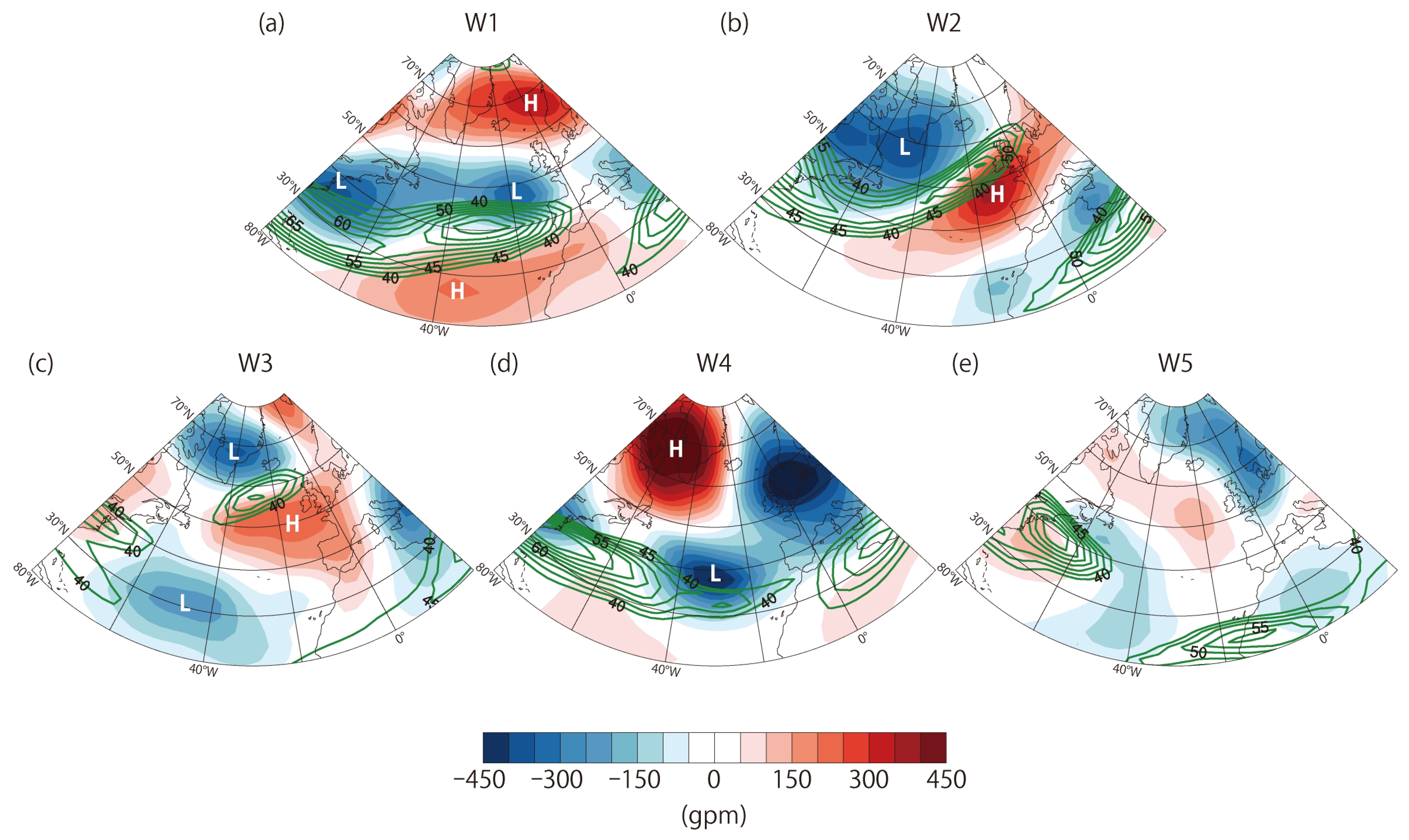
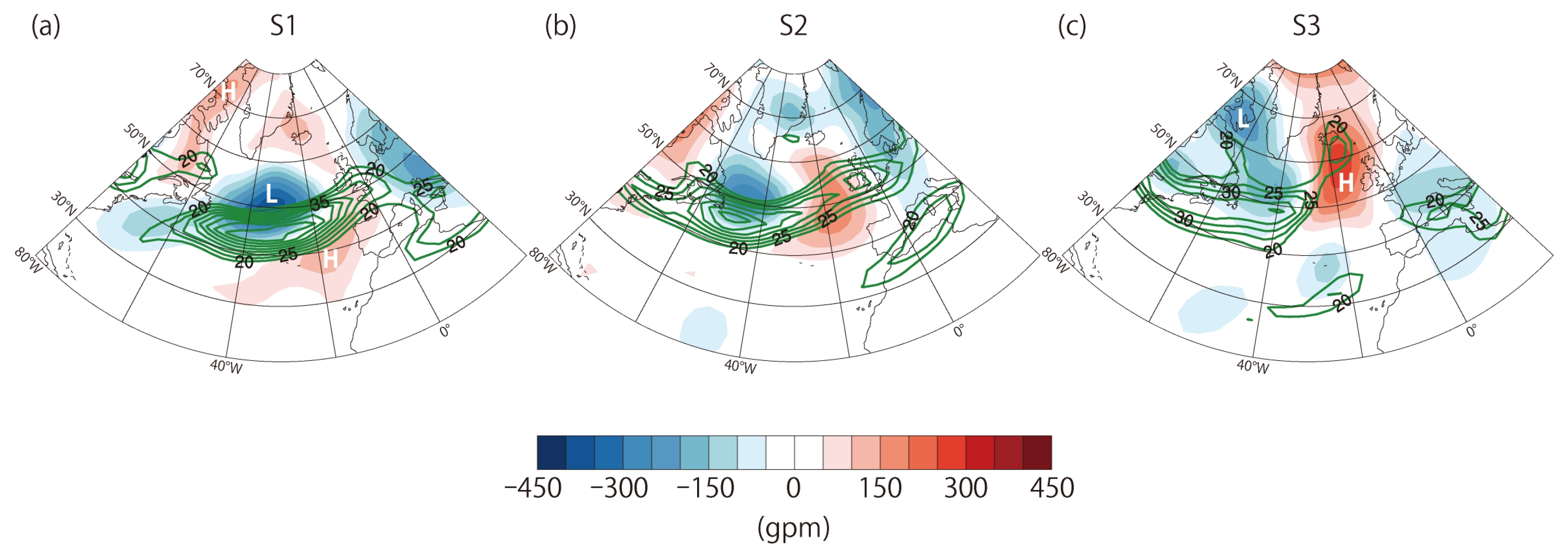

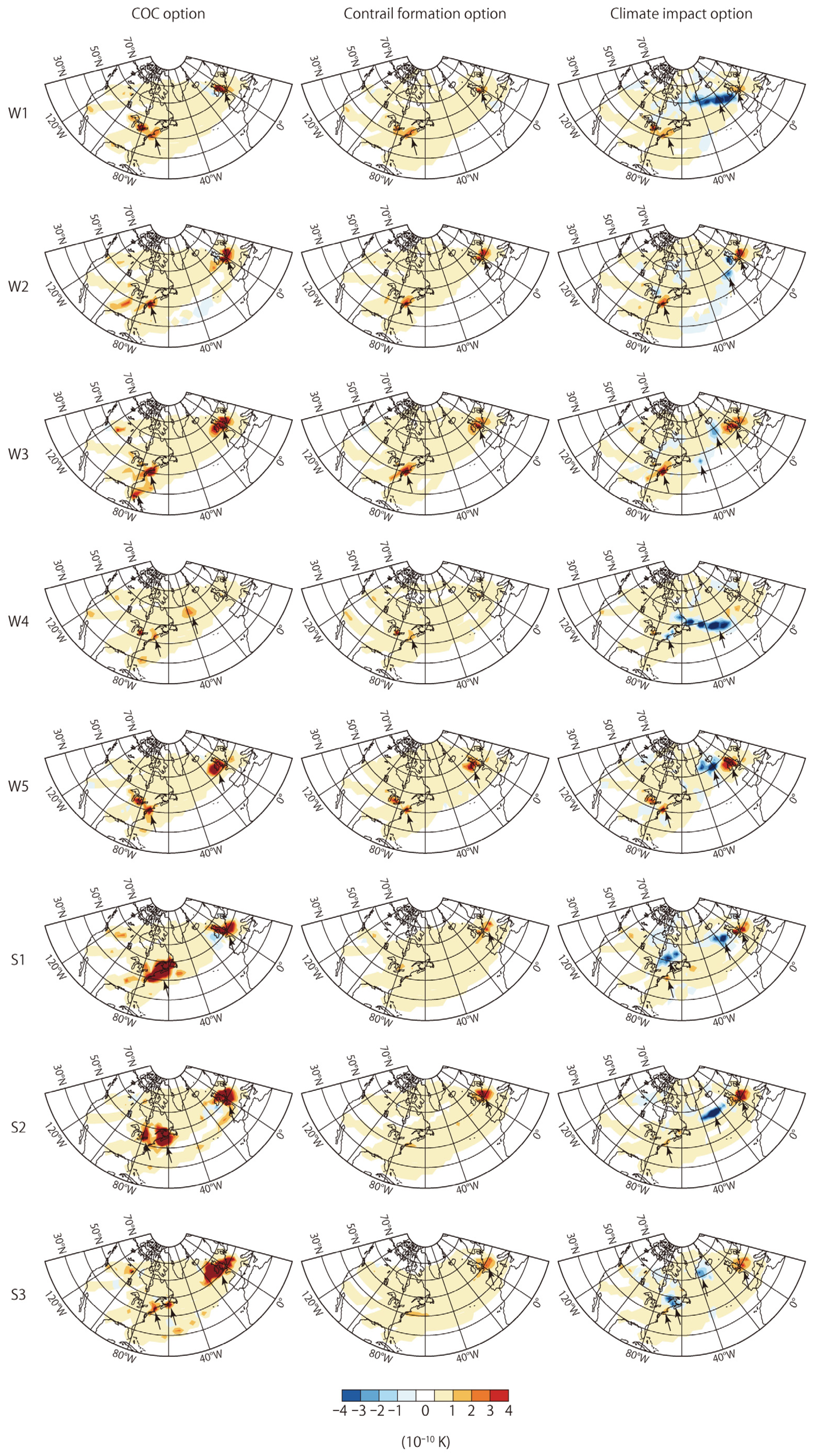
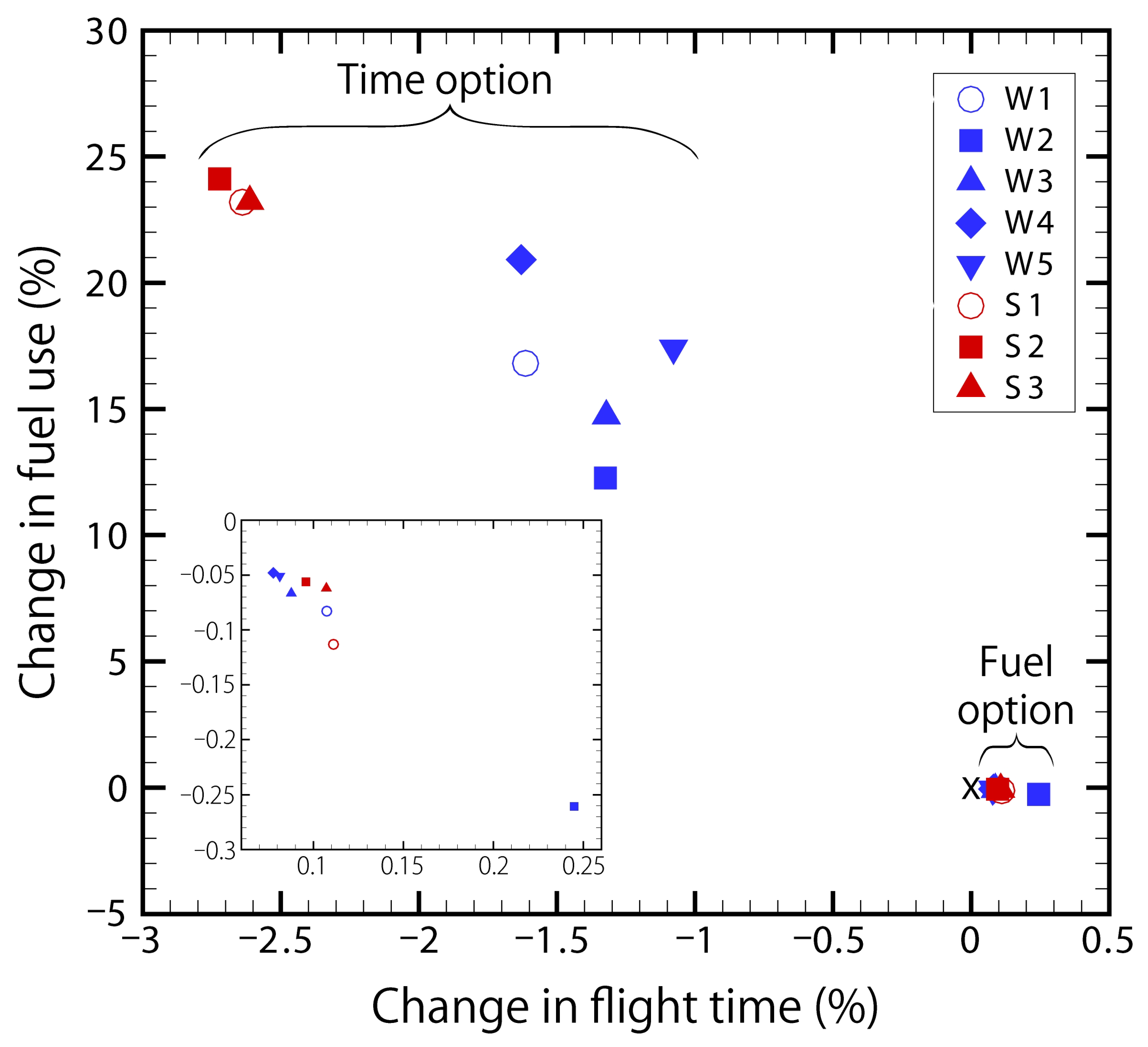
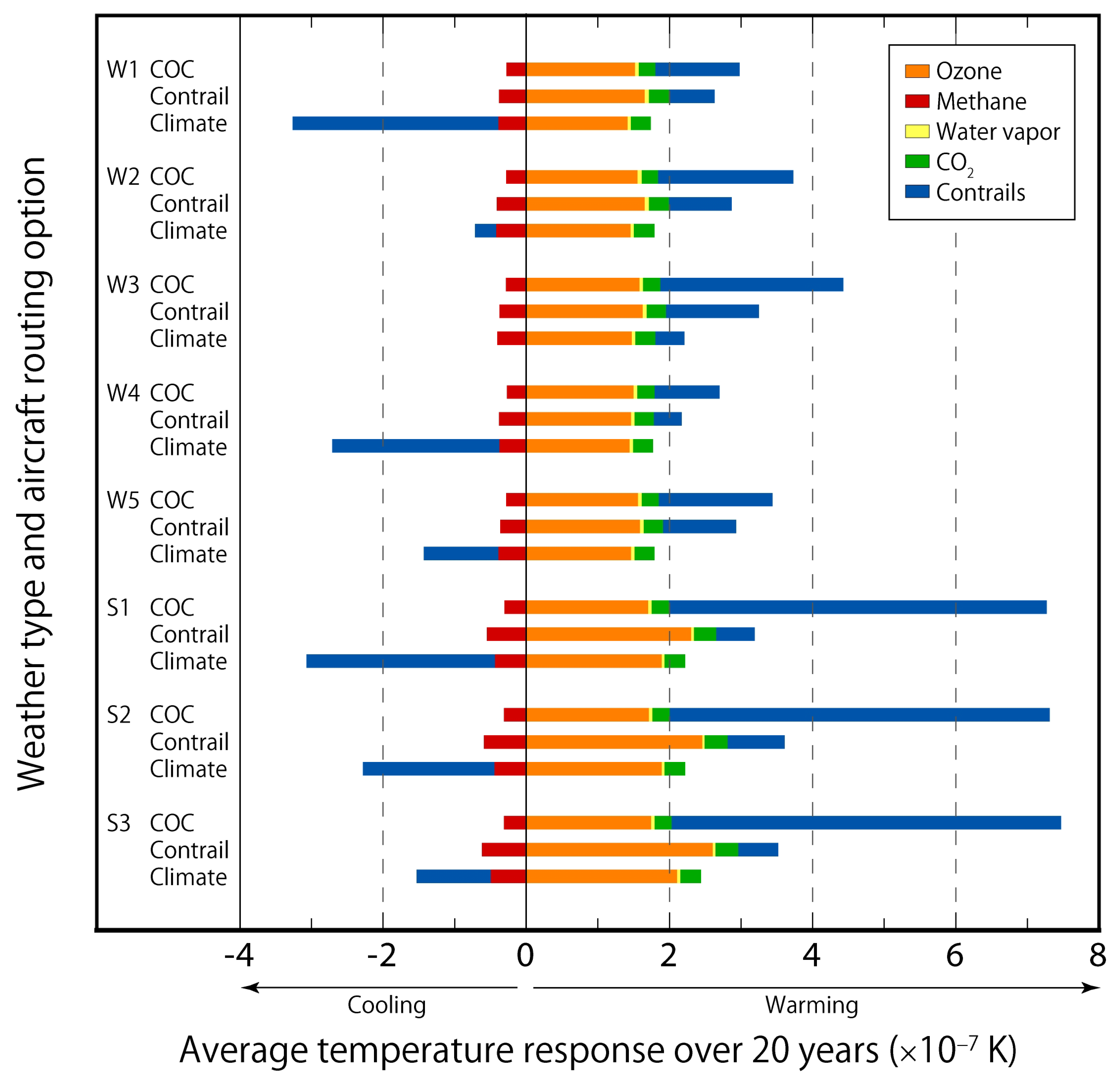
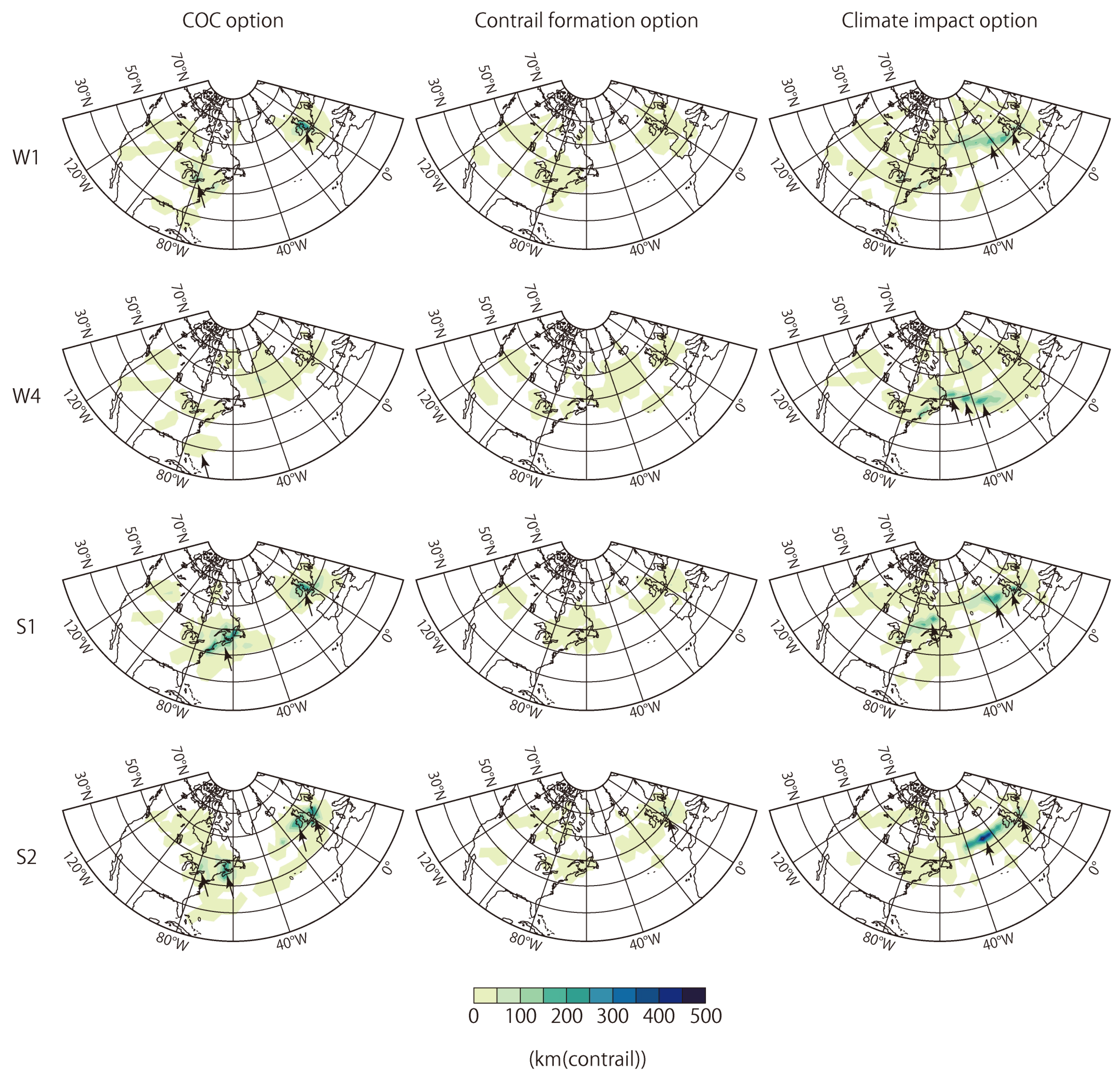

| Parameter | Description |
|---|---|
| ECHAM5 resolution | T42L90MA (2.8° by 2.8° in latitude and longitude, up to 0.01 hPa) |
| Simulation period | December 2008–August 2018 (ten years) |
| Time step length of EMAC | 12 min |
| EMAC mode of operation | Specified dynamics by nudging with ERA-Interim reanalysis dataset |
| Parameter | Description |
|---|---|
| Flight plan | 103 North Atlantic flights (52 eastbound/51 westbound) [11,45] |
| Simulation period | One day |
| Aircraft/engine type | A330-301/CF6-80E1A2, 2GE051 (with 1862M39 combustor) |
| Mach number | 0.82 |
| Flight altitude change | [FL290, FL410] (≈ [8.8, 12.5] km) |
| Number of waypoints | 101 |
| Aircraft routing option | Flight time, fuel use, COC, contrail formation, climate impact |
| Coupled submodels | CONTRAIL, ACCF |
| Design variable | 11 (6 locations and 5 altitudes) |
| Population size | 100 |
| Number of generations | 100 |
| Selection | Stochastic universal sampling |
| Crossover | Blend crossover BLX-α (α = 0.2) |
| Mutation | Revised polynomial mutation (rm = 0.1; ηm = 5.0) |
| Type | NAO/EA Indices | Jet Stream Position/Strength | Frequency (Days/Season) | Representative Day in 2008–2018 |
|---|---|---|---|---|
| W1 | EA+ | Zonal/strong | 14.7 | 12 January 2010 |
| W2 | NAO+ | Tilted/strong | 17.8 | 1 January 2015 |
| W3 | EA− | Tilted/weak | 18.9 | 9 January 2012 |
| W4 | NAO− | Confined/strong | 16.8 | 20 December 2009 |
| W5 | Mixed | Confined/weak | 22.0 | 19 February 2012 |
| S1 | EA+ | Zonal/strong | 26.0 | 11 July 2009 |
| S2 | Mixed | Weakly tilted/weak | 43.1 | 1 August 2016 |
| S3 | EA− | Strongly tilted/weak | 22.9 | 26 July 2011 |
Publisher’s Note: MDPI stays neutral with regard to jurisdictional claims in published maps and institutional affiliations. |
© 2021 by the authors. Licensee MDPI, Basel, Switzerland. This article is an open access article distributed under the terms and conditions of the Creative Commons Attribution (CC BY) license (http://creativecommons.org/licenses/by/4.0/).
Share and Cite
Yamashita, H.; Yin, F.; Grewe, V.; Jöckel, P.; Matthes, S.; Kern, B.; Dahlmann, K.; Frömming, C. Analysis of Aircraft Routing Strategies for North Atlantic Flights by Using AirTraf 2.0. Aerospace 2021, 8, 33. https://doi.org/10.3390/aerospace8020033
Yamashita H, Yin F, Grewe V, Jöckel P, Matthes S, Kern B, Dahlmann K, Frömming C. Analysis of Aircraft Routing Strategies for North Atlantic Flights by Using AirTraf 2.0. Aerospace. 2021; 8(2):33. https://doi.org/10.3390/aerospace8020033
Chicago/Turabian StyleYamashita, Hiroshi, Feijia Yin, Volker Grewe, Patrick Jöckel, Sigrun Matthes, Bastian Kern, Katrin Dahlmann, and Christine Frömming. 2021. "Analysis of Aircraft Routing Strategies for North Atlantic Flights by Using AirTraf 2.0" Aerospace 8, no. 2: 33. https://doi.org/10.3390/aerospace8020033
APA StyleYamashita, H., Yin, F., Grewe, V., Jöckel, P., Matthes, S., Kern, B., Dahlmann, K., & Frömming, C. (2021). Analysis of Aircraft Routing Strategies for North Atlantic Flights by Using AirTraf 2.0. Aerospace, 8(2), 33. https://doi.org/10.3390/aerospace8020033







